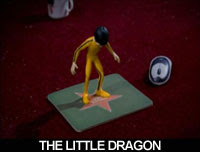Hot Docs ’23: Praying for Armageddon
**½/****
directed by Tonje Hessen Schei
Hot Docs, the Canadian International Documentary Festival, runs from April 27-May 7, 2023. Visit the fest’s official site for more details.
by Bill Chambers Praying for Armageddon is about the mobilization of Christian evangelicals, who, according to on-screen statistics, now make up 30% of American voters. That’s scary, but as the movie makes clear, no number is too small to set off alarms. We meet Pastor Gary Burd of the Mission M25 Ministry/motorcycle club, who says, “I don’t want you to think that I am raising a militia,” but holds his sermons in a bunker and knights his congregants so they may take up swords against whatever windmills the evangelicals are tilting at this week. “Swords” is uttered often in Praying for Armageddon, for what it’s worth. Jesus was a war hawk, according to Burd, who quotes Him in Luke 22 as saying, “Yeah, if you don’t have a sword, go sell your coat and buy one, because the time is coming when you’re gonna need a sword.” But the word has an elastic meaning in Christian evangelical-ese, even though influential figures like Christians United for Israel founder John Hagee insist the Bible–which the odious Hagee fashions into an acronym for “Basic Information Before Leaving Earth”–is “literal from cover to cover.” (Burd’s Jesus sounds like Mark Wahlberg, Hagee’s like Gary Busey.) Swords are swords, but they’re also guns, they’re also nuclear weapons. That’s why the so-called Armageddon Lobby (shudder) has concentrated its resources on indoctrinating U.S. soldiers to its religious crusade, which begins with proselytizing new recruits and baptizing them at the end of Basic Training. Presto! A Christian national is born–a perfect mirror image of the ostensible enemy, incidentally. Michigan-based company Tijicon went so far as to supply the Marines with rifle scopes engraved JN8:12, referring to the passage from John that reads, “Whoever follows me will never walk in darkness, but will have the light of life.” This way, you’re aiming Jesus at your targets.

